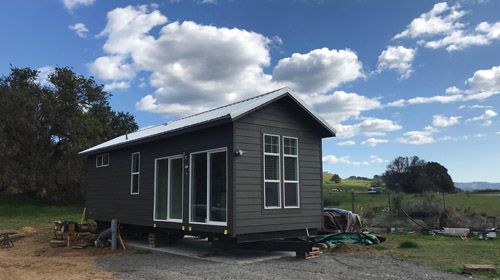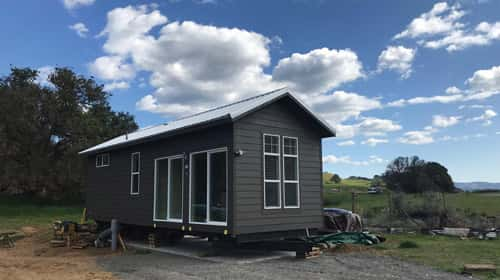
Having a roof over your head is a basic human need, but finding one in Sonoma County can be a challenge. An increasing population that has steadily outpaced the number of new units available and the loss of thousands of dwellings in the wildfires of October 2017 are major contributors to a critical shortage of homes, and the high price of rent keeps people out of local housing, too. It’s a complex problem with no simple answers, but creative thinking, resourcefulness and collaboration are leading to a variety of solutions that go beyond simply erecting buildings to making sure housing is available for everyone, as well as benefiting the community.
A growing problem
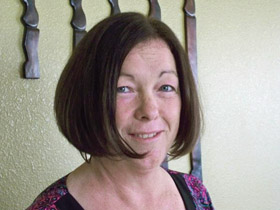 The housing crunch has been in the making for a long time. A McKinsey Global Study, Closing California’s Housing Gap, shows that California gained 544,000 new households between 2009 and 2014, but added only 467,000 new residential units in the same time frame, resulting in insufficient stock throughout the state, according to Jane Riley, comprehensive planning manager for Sonoma County. In addition, she states that since 2008, cuts in federal and state funding have reduced investment in affordable housing production and preservation, causing Sonoma County to experience an 87 percent drop in funding for those purposes, thus deterring builders from developing new projects. Rising construction and labor costs have had an impact as well, further discouraging the incentive for new development.
The housing crunch has been in the making for a long time. A McKinsey Global Study, Closing California’s Housing Gap, shows that California gained 544,000 new households between 2009 and 2014, but added only 467,000 new residential units in the same time frame, resulting in insufficient stock throughout the state, according to Jane Riley, comprehensive planning manager for Sonoma County. In addition, she states that since 2008, cuts in federal and state funding have reduced investment in affordable housing production and preservation, causing Sonoma County to experience an 87 percent drop in funding for those purposes, thus deterring builders from developing new projects. Rising construction and labor costs have had an impact as well, further discouraging the incentive for new development.
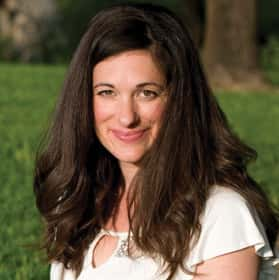 Felicity Gasser, communications manager for the Sonoma County Community Development Commission, observes that finding housing has always been difficult for lower-income residents, but over the last 10 years, it’s gotten worse. “We’ve been calling it a crisis for four years at least. There’s not enough housing. It’s very tight,” she says, but she adds that a shortage is just one aspect of a multifaceted problem. High rents in existing buildings are an issue, and regulations and protecting open space are often factors that increase costs and make building difficult. Infill construction in already developed areas is also pricy because it can involve remediation, environmental cleanup, and responding to the opinions of neighbors who have strong views about what should be allowed. Tariffs that the United States recently levied on foreign suppliers are driving up the cost of building materials as well, adding yet another obstacle to new construction.
Felicity Gasser, communications manager for the Sonoma County Community Development Commission, observes that finding housing has always been difficult for lower-income residents, but over the last 10 years, it’s gotten worse. “We’ve been calling it a crisis for four years at least. There’s not enough housing. It’s very tight,” she says, but she adds that a shortage is just one aspect of a multifaceted problem. High rents in existing buildings are an issue, and regulations and protecting open space are often factors that increase costs and make building difficult. Infill construction in already developed areas is also pricy because it can involve remediation, environmental cleanup, and responding to the opinions of neighbors who have strong views about what should be allowed. Tariffs that the United States recently levied on foreign suppliers are driving up the cost of building materials as well, adding yet another obstacle to new construction.
The greatest impact of the shortage is on low-income households since they’re rent-burdened or must live in overcrowded or substandard houses if they are to stay housed. Gasser explains that it’s a situation affecting those who earn less than $70,000 a year, such as teachers, medical assistants, firefighters and construction workers, who are important to the community but have to pay a much higher percentage of their income for housing than the recommended 30 percent. Because they’re spending so much to stay housed, they often can’t afford food and other necessities, and that has repercussions for the community. “They can’t contribute to local economic growth because they can’t buy consumable goods,” she explains, and it’s a situation that also affects an individual’s quality of life. If, for example, people are working two jobs to make ends meet, they have to limit time with their families and can’t engage in activities that would allow them to be contributing members of the community. As a result, people who could be assets sometimes opt to leave and move to areas that are more affordable.
Seeking solutions
It’s a tangle of interrelated problems that needs alternatives to past approaches. As a result, officials in Sonoma County and the City of Santa Rosa are venturing down new paths. A strategy that Gasser believes is promising is the creation of a renewal enterprise district, which Sonoma County and the City of Santa Rosa both approved earlier this year. She describes it as a financing and government structure that allows local governments to prioritize housing development that meets certain policy goals such as being affordable, transit-oriented, climate smart and infill. Through a joint powers authority, two entities will work together to pool and leverage funding for development and provide regulatory relief, which would give developers the resources and support they need to move forward with projects. “Narrow regulatory relief for housing developments that meet a defined set of public policy goals would help to catalyze the market,” she says. Efforts would also focus on placing housing in urban cores, include affordable components and energy efficiency and advance social equity. Key to its success is taking a regional approach. “It’s critical that we work as a region,” says Gasser. “The more we can have regional conversations and collaboration, the better it will be and facilitate more building.” She reports that Sonoma County needs 30,000 new units to meet the need. “If we build in areas that we’ve already agreed are good places to build, then we’d meet that goal,” she says. The JPA initially involves only Sonoma County and the City of Santa Rosa, but she believes it’s likely that the partnership will expand to include the county’s other eight incorporated cities as the benefits become apparent.
David Guhin, assistant city manager and planning and economic development director for the City of Santa Rosa, observes that construction slowed down during the recession and has not recover quickly. “Coming out of the recession, the housing market slowly rebounded. The number of housing unit permits issued were going up, but not at the pace we needed,” he says, reporting that new housing units totaled 300 or 400 a year instead of the 800 Santa Rosa required. He attributes the lag to several variables, including the cost of labor and materials for construction, a difficult permit process and the price and availability of land.
Santa Rosa’s approach to solving the problem was developing a housing action plan with five program areas that have goals for addressing the housing problem in the following ways: increasing inclusionary affordable housing; achieving affordability by designing in market-rate projects; assembling and offering public land for development; improving development readiness; and increasing affordable housing investment and partnerships. In addition, the city’s permitting department undertook a process improvement effort to address time, certainty and cot of getting housing projects through the entailment process and ultimately through the building permit process.
The Housing Action Plan goals address all five program areas and include 31 program elements, thereby providing a variety of approaches. “We realize we have to address this housing crisis from different fronts,” says Guhin. “It’s important to consider the problems from the standpoint of both policy and process,” he adds.
Identifying where to increase density of housing development is one of the first steps, and Santa Rosa is taking an aggressive approach to placing more housing downtown. “We need to show we’ve got the political will, policies, processes, fee structure and vision to do this,” says Guhin. City council has demonstrated its commitment by making urban housing one of its top priorities. It is evaluating the use of all the downtown property the city owns for housing, which it will develop in partnership with developers. And to encourage development in the downtown, the City has implemented policy changes, expedited permitting processes and the federal government has designated downtown Santa Rosa an opportunity zone, which will allow investors to defer taxes on prior capital gains for 10 years if they reinvest in distressed areas. “It puts revenue back into the downtown core and allows us to create a diverse housing stock at all affordability levels,” says Guhin. The aim is to locate new market rate and affordable housing units in places where people can live close to their jobs and public transit, which would encourage walking and reduce traffic. To further increase a diverse downtown housing stock, the city is also developing processes and policies to allow greater density. That could mean allowing buildings to go higher than the current 10-story limit, perhaps to 14 or more stories. Santa Rosa has the funding and is starting an update to the downtown specific plan that will include extensive public engagement to make the revisions necessary to allow a height increase, Guhin explains, which would make the creation of downtown housing more feasible.
One of the city’s goals in building downtown housing, which will include a mix of apartments and condominiums for rent, is to meet a demand from employers. “They want to attract employees who want to live in a downtown environment,” he says. Guhin adds that urban development is an environmentally sound practice because consolidating activities downtown is less expensive than building housing in undeveloped areas on the outskirts. He adds, however, that’s it’s important to build in the right way, and that includes respecting boundaries with historic neighborhoods and addressing parking issues.
Riley reports that Sonoma County is also encouraging higher densities at multifamily developments, such as Estancia Apartments in an unincorporated area of north Santa Rosa, which contained 74 units before the firestorm and will have 96 when it’s rebuilt. The creation of a new workforce housing combining zone will also encourage higher-density building near jobs, transit and urban service areas. In addition, the county is considering missing middle housing, such as cottage housing developments, which are usually small single-family homes clustered around a common area, often in infill areas.
 Permit Sonoma, the county’s permit and resource management department, conducts reviews, issues permits and inspects construction and land development in the county’s unincorporated areas. In May, the Board of Supervisors approved changes to the Sonoma County Code, and the new regulations went into effect in June. Communications Manager Maggie Fleming explains that the intent of the changes is to reduce constraints to housing production and to provide broader options for permanent housing solutions. “Permit Sonoma will be bringing more housing initiatives to the Board of Supervisors this fall. The goal of these initiatives is to expand housing opportunities and encourage new types of housing in appropriate areas,” she says. Parallel efforts currently underway include the Sonoma Airport SMART Station Specific Plan and Sonoma Springs Specific Plan. Both are examples of areas where increased housing density may be considered. The Board of Supervisors adopted several urgency ordinances after the fires to address the urgent need for housing for victims. Among them were incentives for the expansion of mobile home sites and the construction of accessory dwelling units (ADUs) in areas zoned for single-family dwellings. The new housing initiatives allowed an increase in size and reduced fees on a graduated scale, and by June, Permit Sonoma had issued 21 permits for ADUs in the burn zone.
Permit Sonoma, the county’s permit and resource management department, conducts reviews, issues permits and inspects construction and land development in the county’s unincorporated areas. In May, the Board of Supervisors approved changes to the Sonoma County Code, and the new regulations went into effect in June. Communications Manager Maggie Fleming explains that the intent of the changes is to reduce constraints to housing production and to provide broader options for permanent housing solutions. “Permit Sonoma will be bringing more housing initiatives to the Board of Supervisors this fall. The goal of these initiatives is to expand housing opportunities and encourage new types of housing in appropriate areas,” she says. Parallel efforts currently underway include the Sonoma Airport SMART Station Specific Plan and Sonoma Springs Specific Plan. Both are examples of areas where increased housing density may be considered. The Board of Supervisors adopted several urgency ordinances after the fires to address the urgent need for housing for victims. Among them were incentives for the expansion of mobile home sites and the construction of accessory dwelling units (ADUs) in areas zoned for single-family dwellings. The new housing initiatives allowed an increase in size and reduced fees on a graduated scale, and by June, Permit Sonoma had issued 21 permits for ADUs in the burn zone.
Santa Rosa has also seen an increase in application for ADUs, after addressing fees and parking issues earlier this year. “A large part of the fee eliminated for second units of 750-square-feet or less, and reduced substantially for second units up to 1,200-square-feet was waived. That was a pretty dramatic change,” says Guhin.
New approaches
 ADUs are increasingly in demand for a variety of purposes. “We are selling to people who are putting them on a piece of land or lot that already has a primary dwelling. They are using the established infrastructure,” says Stephen Marshall, owner of The Little House on the Trailer in Petaluma. His business offers two types of manufactured homes. The smallest is on wheels and is categorized as a recreational trailer, so it’s considered a piece of personal property rather than a building. Sonoma, Napa and Mendocino counties offer a special use permit to occupy a recreational trailer. The larger is an accessory dwelling unit (a second unit) up to 1,000 square feet and requires a building permit. “They’re ADUs because they’re code-conforming,” says Marshall.
ADUs are increasingly in demand for a variety of purposes. “We are selling to people who are putting them on a piece of land or lot that already has a primary dwelling. They are using the established infrastructure,” says Stephen Marshall, owner of The Little House on the Trailer in Petaluma. His business offers two types of manufactured homes. The smallest is on wheels and is categorized as a recreational trailer, so it’s considered a piece of personal property rather than a building. Sonoma, Napa and Mendocino counties offer a special use permit to occupy a recreational trailer. The larger is an accessory dwelling unit (a second unit) up to 1,000 square feet and requires a building permit. “They’re ADUs because they’re code-conforming,” says Marshall.
Legal use (the demand) for the houses on wheels is primarily for use as a homecare cottage. Marshall explains that an elderly person might own a big house and need care to stay there. In that case, the owner might purchase a home-care cottage (house on wheels) and place it on the property for a caregiver. Alternatively, he or she might opt to live in the smaller house and have children and grandchildren take up residence in the main house in exchange for care. “That’s a common arrangement. It’s remarkable how often that’s the case,” he says. He also observes that young families are frequently priced out of the local real estate market, and when families consolidate in this way, it allows the next two generations to stay in the community. He recently put a larger accessory dwelling unit (house on wheels) on a cattle ranch near Calistoga, for example, because the owner’s children and grandchildren needed a home. Marshall reports that he’s placed 50 home-care cottages throughout the county in unincorporated areas, but the cities don’t yet allow them. They may also be used as course of construction homes.
The second and larger house, which is categorized as an ADU, is a manufactured house that (took out up to 1,000 feet, because it’s mentioned earlier) requires an engineered foundation and hooks up permanently to utilities. The Little House on the Trailer is currently producing several homes for lots where fires destroyed homes. “It’s turning out to be a good solution for the homeowners to get back there quickly,” says Marshall, adding that the insurance companies are embracing the concept because it allows them to provide interim housing more affordably in a competitive rental market. Once a main house is rebuilt, the owners can use the interim house for income, and Marshall reports that the rent for a 1,000-square-foot house pre-fire was about $2,500. Among the other advantages, adds Marshall, ADUs increase density and use developed land and infrastructure, and filling in is better than sprawl.
On a larger scale, modular housing is gaining ground. Pauline Block, marketing manager for Cornerstone Properties, a North Bay developer and building owner, reports that the company has been exploring alternative building methods, such as modular multi-family workforce developments for some time. “We see a huge need for alternative construction in order to execute and deliver housing to our community quickly,” she says. Recognizing the urgent need, she explains that modular buildings can be ready in months instead of years and says, “We need to move quickly if we want to keep our teachers, nurses, doctors, firefighters, police and other service professionals in Sonoma County. They need an affordable place to live if they’re going to stay here and continue to serve our community.”
Matching needs
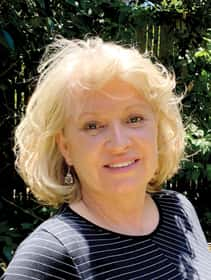 For people who have little or nothing at all to spend on rent, SHARE Sonoma County arranges home shares throughout the county. “My program specifically focuses on our aging population,” says executive director Amy Appleton, who explains that many older homeowners are property-rich but cash-poor and have bedrooms they’re not using. She estimates that Sonoma County has upwards to 60,000 empty bedrooms within households of those 60 years and older, and SHARE Sonoma County can arrange for screened and approved tenants to live in them and provide carefully defined services in lieu of rent if the home provider/owner is in need of additional income. “I’ve got people who’ve been priced out of the rental market and are sharing out of necessity. They have a limited income and just can’t afford to rent an apartment,” she says. She notes that the individuals she places are typically not those who have behavioral issues or have experienced long-term homelessness and are chronically homeless. Rather, they’re people with a limited income who are often working and don’t earn enough to pay rent. Before recommending someone for placement, she does a background check and arranges a home visit to meet with the homeowner for an in-depth meeting. “I meet everyone on their level. I really try hard to find out what their needs are and that all expectations are met,” she says. Among the people she finds rooms for are Baby Boomers who can no longer afford rent, people who’ve had health problems, women escaping domestic violence and students at Santa Rosa Junior College and Sonoma State University who can’t afford housing and are couch-surfing. She also created an emergency program for fire victims, SHAREFire.org, and some of the property owners discovered it was fun to have someone in their homes and plan to continue more traditional home sharing. “There’s such a feeling of companionship, and I am witness to so many life-changing stories” she says, recalling a woman who kept on her television set 24 hours a day because she felt so alone. Now, with home sharing, she enjoys having a companion and called to let her know recently that the television was no longer on.
For people who have little or nothing at all to spend on rent, SHARE Sonoma County arranges home shares throughout the county. “My program specifically focuses on our aging population,” says executive director Amy Appleton, who explains that many older homeowners are property-rich but cash-poor and have bedrooms they’re not using. She estimates that Sonoma County has upwards to 60,000 empty bedrooms within households of those 60 years and older, and SHARE Sonoma County can arrange for screened and approved tenants to live in them and provide carefully defined services in lieu of rent if the home provider/owner is in need of additional income. “I’ve got people who’ve been priced out of the rental market and are sharing out of necessity. They have a limited income and just can’t afford to rent an apartment,” she says. She notes that the individuals she places are typically not those who have behavioral issues or have experienced long-term homelessness and are chronically homeless. Rather, they’re people with a limited income who are often working and don’t earn enough to pay rent. Before recommending someone for placement, she does a background check and arranges a home visit to meet with the homeowner for an in-depth meeting. “I meet everyone on their level. I really try hard to find out what their needs are and that all expectations are met,” she says. Among the people she finds rooms for are Baby Boomers who can no longer afford rent, people who’ve had health problems, women escaping domestic violence and students at Santa Rosa Junior College and Sonoma State University who can’t afford housing and are couch-surfing. She also created an emergency program for fire victims, SHAREFire.org, and some of the property owners discovered it was fun to have someone in their homes and plan to continue more traditional home sharing. “There’s such a feeling of companionship, and I am witness to so many life-changing stories” she says, recalling a woman who kept on her television set 24 hours a day because she felt so alone. Now, with home sharing, she enjoys having a companion and called to let her know recently that the television was no longer on.
Solving the housing crisis is an ongoing process, and finding shelter for everyone and maintaining the qualities of a lifestyle that people value is a challenge. The determination and resourcefulness of the people seeking solutions, however, is starting to make a difference. It will inevitably bring changes, but in the long-term, the intent is to make life better for everyone.
2016-2020: Employment and housing needs
To determine the number of housing units needed in Sonoma County following the Complex Fires, the Sonoma County Economic Development Board hired Beacon Economics, an independent Los Angeles consulting firm that specializes in economic research to prepare a housing and fiscal impact report. Beacon established a relationship between employment and housing units to make the following projections:
Civilian Employment:
2016: 254,696
2020: 267,927
Change: 13,231
Workforce Housing Units:
2016: 158,553
2020: 166,696
Change: 8,143
Source: Beacon Economics
Parking Spaces
More housing suggests more cars, but that’s not necessarily the case. David Guhin, Santa Rosa’s assistant city manager and planning and economic development director, points out that multi-family buildings currently require a specific number of parking spots per unit, but reducing the requirement is a possibility and is being encouraged. The city also encourages the unbundling of parking from individual units, car-sharing and other creative parking options.
“We don’t want to just blindly put in parking spots and ultimately add to cost of the individual unit,” he says.
Section 8 Low-income Challenge
Income is an issue for earners at the low end of the scale, who find rents in Sonoma County’s competitive market prohibitively high. They can take advantage of the Housing Choice Voucher Program—also known as Section 8—in which the U.S. Department of Housing and Urban Development provides assistance through housing authorities for them to rent market-rate units. “In such a tight market, it can be difficult to find an available unit where they can use their vouchers,” says Felicity Gasser, Sonoma County Community Development Commission, so they have to find either a benevolent landlord or subsidized housing.
Homeless Count
Sonoma County’s 2018 annual 24-hour Homeless Count, which the Community Development Commission conducted on February 23, 2018, suggests that the number of people without housing has increased as a result of the wildfires of October 2017. In contrast to previous years, when the count showed a decline, this year, the number was up 6 percent. The count found 2,996 homeless people, up 161 from 2017. In addition, 1,067 people were living in shelters or transitional housing for the homeless, an increase of 79. The report observes that while the increase is small, it is likely only the first wave of homelessness due to the fires, and that as more people run out of resources, and the market pushes housing out of reach, the number will climb. See the full report at www.sonomacounty.ca.gov/CDC/News/2018-Homeless-Count-Report-Now-Available/


